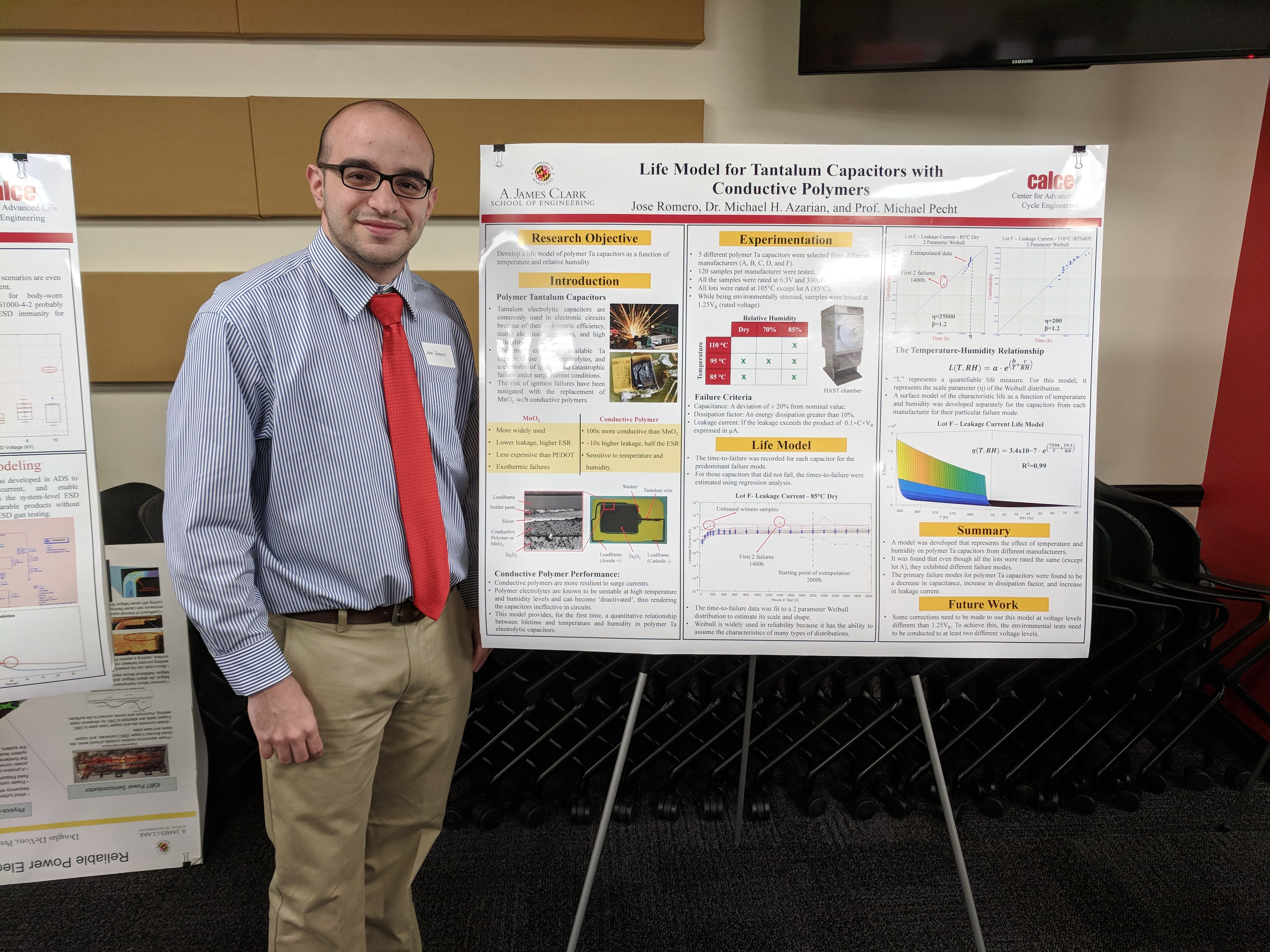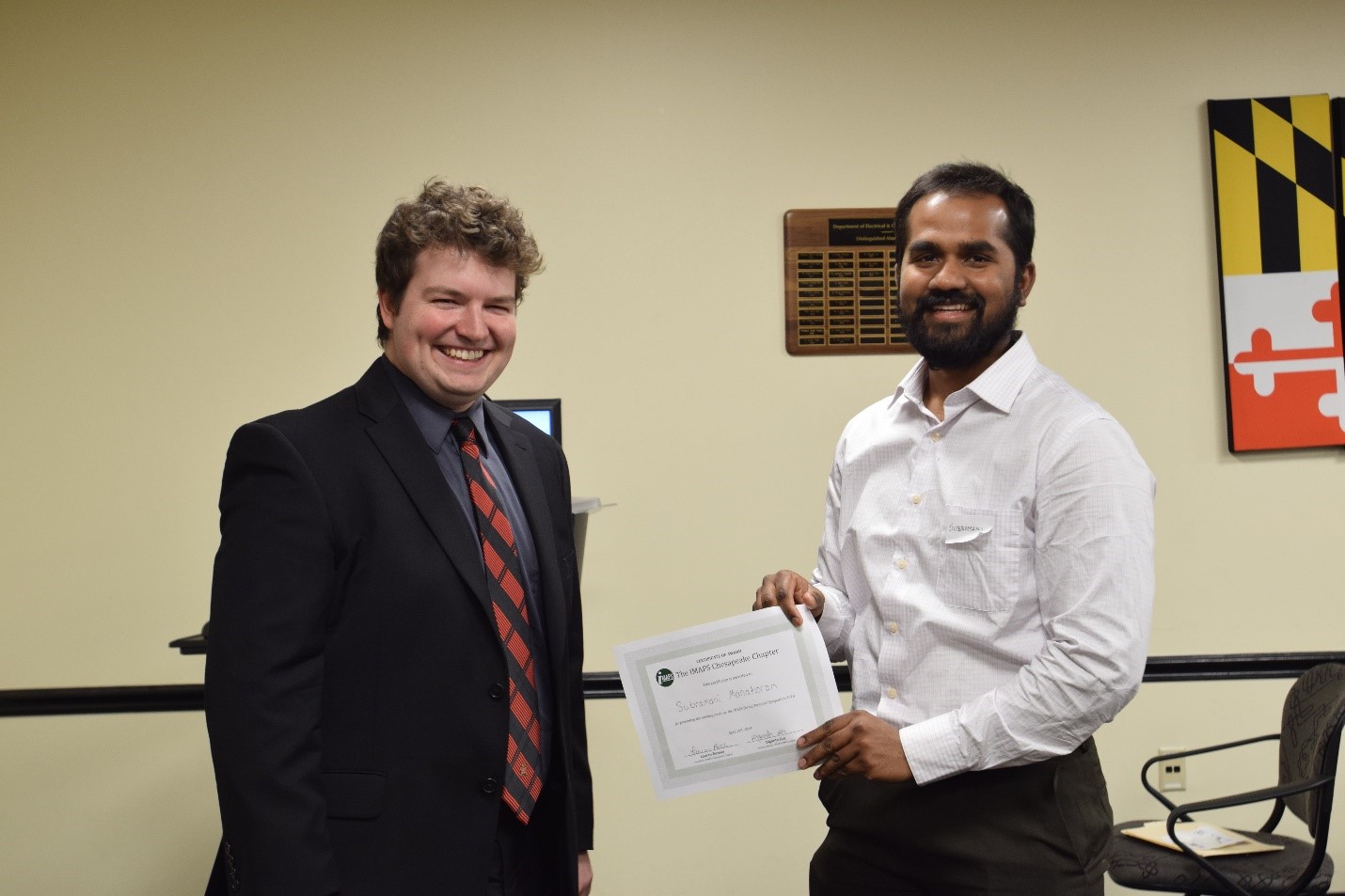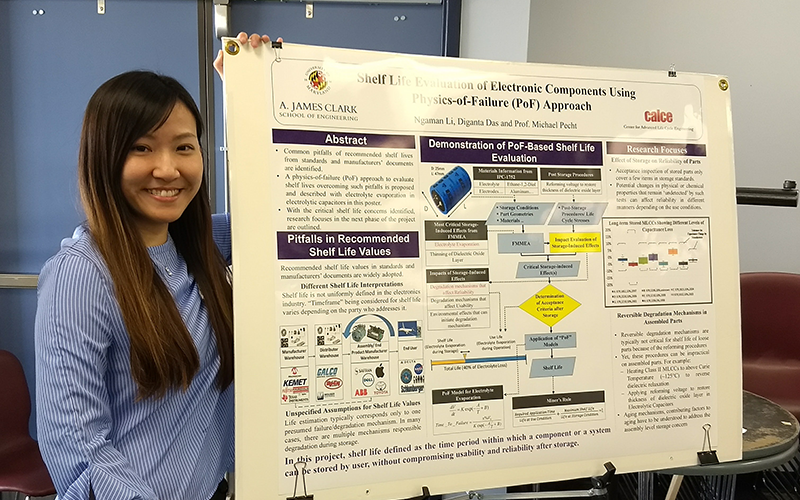Thursday, November 19, 2020
4:00 p.m.-6:00 p.m.
Virtual Event
Suraj Ravimanalan
The Center for Advanced Life Cycle Engineering (CALCE) at the University of Maryland, College Park, along with its student chapters – IPC, iMAPS, and SMTA will jointly host an online/virtual 5-minute elevator pitch contest as part of the Fall Technical Symposium 2020 on November 19,2020.
The elevator pitch aims to describe the research/project’s need to be conducted, its background, objectives, scope, interim or final results, and benefits to the organization and broader society. The topics for the presentation are inclusive of any subjects relevant to the electronics industry. Some of the suggested topics are as follows:
- Materials & Processing·
- Photonics
- Packaging technology
- Interconnects·
- Applied Reliability
- Emerging Technologies – Artificial Intelligence, Machine Learning
- Assembly & Manufacturing Technology
- Thermal or mechanical simulation & characterization
The top three presenters will be awarded cash prizes of $300, $200, and $100 respectively. Also, the ten selected participants will receive appreciation gifts.
Interested applicants should use the following link to learn more and submit an abstract for the event. The abstract submission deadlines have been extended to 9th November, with selection of abstracts and declaration to the top 10 selected participants by November 10th. November 11th - November 16th is the duration for the presentation submission.
Registration Link: https://www.eventbrite.com/e/technical-fall-symposium-elevator-pitch-contest-tickets-126605491433
Abstract Submission Link: https://forms.gle/jnDCyouGM4UDJE6j9
Click here to view the timeline for the event.
For any event-related details, such as deadlines for submission, presentation topics along with the registration link can be found in the attached flyer.
Other general inquiries, please contact: Dr. Diganta Das
Wednesday, March 6, 2019
3:00 p.m.-7:00 p.m.
Johns Hopkins Applied Physics Laboratory (APL), Laurel, MD
Subramani Manoharan
The IMAPS Chesapeake Chapter combined with the University of Maryland student chapter of IMAPS and SMTA, will hold its Spring Technical Symposium on March 6th, 2019, at the Applied Physics Laboratory (APL) of Johns Hopkins University. The symposium will focus on emerging trends in electronics packaging and their reliability concerns. This will be the first collaborative meeting between IMAPS and SMTA student chapters, and is expected to attract people with a wide range of background hence providing great networking opportunity for students and professors.
The event will kick off with speeches from eminent speakers on topics covering thermal aspects of power module packaging, bi-metal interface degradation in wire bonds and trends in packaging materials and its reliability. There will also be exhibits showcasing products and services that are of importance to the electronics packaging and reliability personnel. Dinner will be served for all attendees and participants. Selected topics will be presented as posters by the students of University of Maryland during the dinner session.
Additional information can be found here.
The IMAPS Chesapeake Chapter held its annual Spring Technical Symposium on April 18th, 2018, at the University of Maryland, College Park. The event was held in association with the Center for Advanced Life Cycle Engineering (CALCE). The symposium included a poster and 3 Minute Thesis competition for all graduate and undergraduate students and a peek inside the research and testing that goes on within CALCE.
The evening began with the 3 Minute Thesis Competition during which time the participants briefly presented their research work and were evaluated by all members of the audience. The judged criteria included presenter performance, enthusiasm, thesis topic, creativity, presentation skills, and depth of knowledge. CALCE student Jose Romero won the competition and the $50 award.
The student poster competition followed. Of the submissions received, eleven finalists were chosen to present at the event. A summary of each of the poster topics and presenters is provided below.
| Presenter |
Topic |
University / Organization |
| Nripendra Patel |
Reliability Assessment of Strontium based Perovskite Electrodes of Solid Oxide Fuel Cells |
University of Maryland |
| Yi Wu |
Analysis of Manufacturing-Induced Defects in Lithium-Ion Batteries Using Computed Tomography |
Nanjing University of Aeronautics and Astronautics |
| Lingxi Kong |
Interaction of Lithium Dendrite Growth with Separator |
University of Maryland |
| Weiping Diao |
Electrical Current Distribution in Lithium-ion Battery Packs with Parallel Connections |
University of Maryland |
| Mehdi Kohani |
Analyzing the Characteristics of Electrostatic Discharge Events in Wearable Medical Devices |
University of Maryland |
| Subramani Manoharan |
Bond Pad Effects on Shear Strength of Copper Wire Bonds |
University of Maryland |
| Chaobo Shen |
Reliability Assessment for 1200V/450A Dual Channel IGBT Module under Power Cycling and Thermal Cycling |
University of Maryland |
| Saurabh Saxena |
Accelerated Testing and Modeling of High Energy LiCoO2 cathode-based Lithium-ion Batteries |
University of Maryland |
| Lovlesh Kaushik |
Selection of Lubricants for Electronic Connectors Based on Contact Resistance Behavior |
University of Maryland |
| Masuma Khatoon Ema |
Characterization of Thermal Runaway Behavior of Commercial Lithium ion Battery |
University of Maryland |
| Jose Romero |
Life Model for Tantalum Capacitors with Conductive Polymers |
University of Maryland |
The judging for the competition was based on five topics: clarity of work, creativity of research, merit of research, presentation skills, and overall depth of knowledge. The winner of the event and the top prize of $200 was Subramani Manoharan, who presented on bond pad effects on shear strength of copper wire bonds. Saurabh Saxena was awarded second place for his presentation on accelerated life testing of lithium ion batteries and Mehdi Kohani received the third place prize for his work on electrostatic discharge events in wearable medical devices.
The IMAPS Chesapeake Chapter held a Fall Technical Symposium on November 2nd, 2017, at the Applied Physics Laboratory (APL) of Johns Hopkins University. The symposium focused on the reliability issues and emerging trends in multilayer packages and simulation techniques. This symposium was also jointly organized by the IMAPS University of Maryland (UMD) student chapter.
The evening began with a technical presentation by Bhanu Snood from the NASA Goddard Space Flight Center. Mr. Snood presented on recent work analyzing the degradation of the glass-fiber and epoxy interface in printed circuit boards. The second talk was by Rory Grondin from LPFK Laser & Electronics. Mr. Grondin presented on the use of direct laser etching as a processing technique. The final talk of the symposium was given by Dr. Will McKinzie of WEMTEC, inc. Dr. McKinzie presented on recent advances in low temperature cofired ceramic processing through the use of ultraviolet laser ablation. The proceedings for the day concluded with a dinner, giving the members of the chapter, speakers, and guests an opportunity to interact with each other.
Speakers and Abstracts
Speaker: Bhanu Snood | Presentation Title: An Examination of Glass-Fiber and Epoxy Interface Degradation in Printed Circuit Boards
Abstract: Multi-layer organic laminates, which make up over 90% of the present types of interconnecting substrates in today's electronics, can develop a loss of electrical insulation resistance between two conductors due to the conductive anodic filament phenomenon. The filament forms in two steps - a degradation at the polymer/glass fiber interface followed by an electrochemical reaction involving electro-deposition. Bond degradation between the glass and polymer matrix provides a path along which the electro-deposition may occur, the path may result from poor glass treatment, from mechanical stresses during PCB fabrication (such as drilling) and from the hydrolysis of the finish applied on glass fibers. The organosilane bonds between the polymer matrix and glass reinforcements can chemically degrade by hydrolysis or by thermal cycling, which induces stresses at the interface due to a coefficient of thermal expansion (CTE) mismatches. This talk will discuss these filament formation pathways, the key drivers towards degradation, experiments that help in characterizing and tracking the degradation of these interfaces. The experiments include application of nano-scale force/displacement measurements and the use of microscopic infrared spectroscopy to track the evolution of mechanically brittle networks around the glass fibers when the circuit board laminate is exposed to accelerated stress conditions.
About the Speaker: Mr. Bhanu Sood is a Center Lead and Commodity Risk Assessment Engineer (CRAE) for Microelectronics Packaging and Circuit Boards at NASA Goddard Space Flight Center. Mr. Sood serves as NASA GSFC Specialist who manages overall Center development efforts pertaining to electronic circuit assemblies in Goddard Space Flight Center flight missions and ground equipment. Mr. Sood serves as an Agency authority on technical committees and advisory groups and manages the establishment and implementation of new research, technology development and technology demonstration initiatives relating to electronic circuit assemblies. Mr. Sood's areas of expertise include electronics supply chain risks, risk assessment and reliability analysis.
Prior to joining NASA in 2015, Mr. Sood was the Director of Test Services and Failure Analysis Laboratory at University of Maryland's Center for Advanced Life Cycle Engineering (CALCE). In a 10+ year career at UMD, he managed reliability assessments and failure analysis of products from the aerospace, avionics, medical device, telecommunications, oil & gas and automotive industries. In his prior appointment at US Naval Research Laboratory (NRL), Mr. Sood worked on process development for 3D printing, printed micro-power sources, and patented a laser-assisted stereo-lithography based circuit fabrication technique.
Mr. Sood has authored several book chapters, over thirty peer reviewed scholarly and technical papers and several hundred technical reports. Mr. Sood chairs the NASA Printed Circuit Board Working Group and three SAE Aerospace Standards Sub-Committees. He has participated in various conferences organizing committees and currently serves on the ASM Alloy Phase Diagram and ASM Emerging Technologies Awareness Committees. Mr. Sood holds one patent, and two invention disclosures, he is a senior member of IEEE and member of SAE and ASM.
Speaker: Rory Grondin | Presentation Title: Nanosecond and Picosecond Laser Processing for RF and EHF Applications
Abstract: Direct laser etching is rapidly becoming the preferred method for advanced RF/microwave and millimeter wave research applications and production on demand processing. In this presentation, several laser models will be discussed showing the differences in capabilities at near-infrared, green and ultraviolet wavelengths on various materials including PTFE based microwave substrates, flex materials, fired ceramics such as Alumina, AlN, Piezo-ceramics (PZT), Titanate and Low Temperature Co-fired Ceramic (LTCC). Specific examples will also be provided demonstrating laser etched antenna and filter performance in comparison with traditional wet/chemical-etch, simulation software and mechanical milling.
About the Speaker: Rory Grondin has worked with LPKF Laser & Electronics since 2006 advising engineers on the latest applications possible with a range of mechanical milling and advanced laser etching models. Research projects spanning multiple sectors including Government applications, medical research and communication networks have been processed expanding capabilities and enabling new product and design advances. He supports laser tool development for materials research using nano and picosecond laser processing. Rory has a BS degree from Oregon State University and has implemented new techniques for prototype development and production-on-demand processing now used by engineers in North America and around the globe.
Speaker: Dr. Will McKinzie | Presentation Title: Laser Ablation of Low Temperature Cofired Ceramic Packages for Millimeter Wave Antenna Applications
Abstract: Low temperature cofired ceramic (LTCC) materials and conventional screen printing processes are a mature packaging technology for microwave frequency applications. In this presentation we discuss advances in LTCC processing which employ ultraviolet laser ablation to achieve smaller line widths and gaps than is possible with conventional screen printing, as small as 30 um with clean well-formed metal edges. This allows LTCC packaging to be used at higher frequencies including millimeterwave bands up to at least 100 GHz. Manufacturing test structures and two-port millimeter wave circuit test structures will be presented as examples of laser ablated LTCC test vehicles. The fine line and fine gap tolerances of about +/-8 um allow the precise fabrication of circuit transitions, antenna feed networks, matching networks, and electromagnetic bandgap (EBG) structures, all of which are essential for millimeterwave LTCC antennas. Examples of laser ablated LTCC antenna packages will be shown for 60 GHz and 77 GHz. Selected measurement results will be shown for antenna performance.
About the Speaker: Dr. Will McKinzie has been designing millimeter wave packages in silicon and LTCC since 2007, wherein the packages include integrated antennas, vertical transitions, and electromagnetic bandgap (EBG) structures for suppression of surface waves and suppression of internal parasitic modes. He earned a BSEE from the University of MO at Rolla in 1982, and MSEE and PhD EE degrees from UCLA in 1989 and 1992 where he focused on computational electromagnetics for antenna design. He has worked for large companies including Motorola, Northrop Grumman, and Titan as well as startup companies including Etenna Corporation and Paratek Microwave. In 2003, Dr. McKinzie founded WEMTEC, Inc to develop unique EBG concepts for noise suppression in power distribution networks, and for parasitic mode suppression in microwave and millimeterwave packages. He is an inventor on many issued US patents. He currently does consulting work to develop microwave and millimeterwave antennas.


